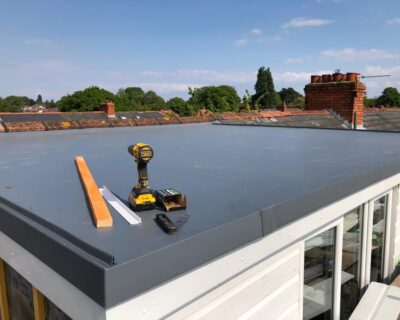Blog & News

Will Water Drain From a Flat Roof?
One of the key questions you may have if you are considering a flat roof is whether the roof will fill up with water when there’s a storm. You may wonder how exactly does a flat roof drain, and will pooling rain water cause damage to your roof over time.
Here at Sureseal, we’ve got all of the answers. Read on to find out more.
Flat Roof Slopes
It’s easy to believe that a flat roof is totally flat – after all, that’s what the name suggests. What you may be surprised to learn is that flat roofs are not entirely horizontal.
Flat roofs have been designed so that they look level, but they have been made with a bit of a slope so that any rainwater will naturally flow into your guttering. So long as your flat roof has been installed correctly, you should never have a roof that has water pooled on top of it.
A flat roof needs to have a 1cm slope for each 60cm of width. This is the minimum requirement.
Ultimately, the roof needs to have a slope of some form so that the water can drain into a central drain, scupper or gutter.
Drainage Systems
Once the water has started traveling downwards down the slope on the flat roof, it needs to go somewhere. There are a few different kinds of drainage used on flat roofs.
Guttering is one of the main kinds of drainage systems used. It’s important that your drainage system is durable and a standard size, and it needs to be able to deal with any bad weather that it may be confronted with.
The roof will need to have an overhang so that the water doesn’t splash or spill on the way to the guttering. The main advantage of this kind of drainage is that it’s affordable and effective, which is why it’s so common! You will need to make sure that you clean it regularly though.
Internal drains are connected into pipes that are positioned beneath the roof in key areas. These drains will take the water from the roof and take it to a proper sewer outlet. These drains are pretty convenient as you can install them in the most convenient place for you. You can also have a custom filter that will stop any clogging in the pipes, and there’s also no need for gutters.
Unfortunately with an internal drain it will be important that you clean and maintain your roof on a regular basis. You’re going to need to remove the filter and check for any blockages that may have been made by things like leaves.
You can use scuppers on railed rooftops. They are essentially just openings in the parapet walls and these will help to transport that water from the roof and into another drainage system such as a gutter.
What Happens If Water Doesn’t Drain from a Flat Roof?
So long as you have been properly maintaining your drainage systems and the drainage and roof have both been installed correctly, water pooling on your roof shouldn’t be an issue.
If you leave water on the roof for too long, however, it can have adverse affects, causing problems with the structural integrity of the roof and more. Ponding water on a roof can give you all sorts of issues, such as reducing how long the roof will last, it can attract insects and mold, it can damage the inside of your home, and it can collect dirt. It will cost you less in the long term in many ways to get it fixed as soon as you are able to.
How to Fix Water Pooling on a Flat Roof – Different Solutions
So if you have water pooling on your flat roof, you may be wondering how you can fix it. Thankfully, you don’t need to deal with water on your flat roof, as there are a number of different solutions to rectify the issue.
Fix any Low Spots
Sometimes low spots can be a problem on flat roofs. The water that pools on the roof will usually drain to the lowest point of the roof and make its way into a drain or gutter, but if you have a low spot on your roof the water will collect there before it manages to get into the drain.
Fixing a low spot is usually best done by a professional roofer, who will fix the low spot with some roofing plaster. This will make the low spot have a slope that matches the rest of the roof’s slope.
Unclogging Drains
Unclogging your drains is the easiest way to prevent water build up on your flat roof. You simply have to make sure that they are well maintained. Check out your drains on a regular basis and get rid of any debris such as sticks, branches and leaves. That way, the water can move from the roof much more easily.
Repitching
Sometimes the reason why the water may not be draining properly from your flat roof is because it simply wasn’t pitched correctly the first time around. When the roof hasn’t been pitched correctly it means that the water is unable to drain properly.
Repitching the roof is a little bit more complicated than the other methods discussed, and it’s important that you make sure you enlist the help of a qualified roofing contractor to do it for you.
This can cost quite a bit of money, so it’s important that you get help from a company that you can trust.
Conclusion
Flat roofs are designed in such a way that water is able to drain off them effectively, as it would with a pitched roof. Sometimes though it may not work out that way, and you will need to take remedial measures to make sure that water doesn’t continue to pool on your roof. If you are looking for more information about flat roofs, get in touch with us today to find out more.



